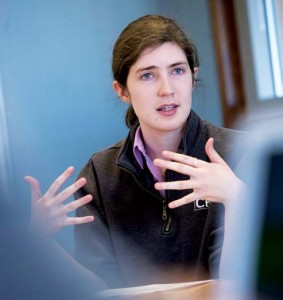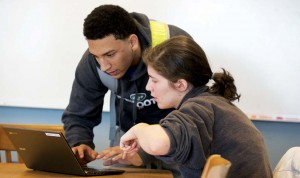 by Brittney Lewer, Fellow in the History Department
by Brittney Lewer, Fellow in the History Department
In high school, I thought of history as a detective game. Piecing together clues from the past, historians would deduce what really happened. Relatively late in my college career, I realized that “what really happened” is, in some ways, a moving target. History is not a fixed set of events, but a narrative that changes based in part on who is telling the story and who the audience is.
Perspective taking — the skill of being able to engage with more than one person’s ideas simultaneously — is vital to this more dynamic version of history. Perspective taking facilitates a richer understanding of past events. Examining Indian Removal from the points of view of President Andrew Jackson, Cherokee Chief John Ross, and contemporary historian Donna L. Akers creates a more complete portrayal of the event than exposure to just one of these perspectives. Historical perspective taking allows us to encounter the complexities and contradictions that inhabit the past, rather than ignore them for the sake of a neater narrative.
In my experience, Milton students know that doing history is not merely reconstructing a master timeline. They know that fully understanding the past requires understanding multiple historical perspectives. I have been interested in cultivating this style of historical thinking in the present. How can students understand what their classmates think about an issue? How can they engage as deeply and mindfully with one another’s contributions as they would with a historical primary source — especially when they disagree with one another? What use is the skill of perspective taking if students learn to apply it only to the distant past, and not to their own world?
 When I started teaching at Milton, I thought that the skill of perspective taking would transfer seamlessly from the past to the present. In my first year, my students could nimbly synthesize multiple, disparate perspectives on the Trail of Tears or the American Revolution. And yet, at the end of a disastrous lesson in which students were asked to discuss how they would respond to a hypothetical draft lottery, I found that my students struggled far more with contemporary perspective taking than with its historical analogue. In a heated discussion, my students struggled to hear one another out. They could absolutely grapple with historical events from multiple perspectives, but considering a classmate’s belief that contradicted their own views was a challenge.
When I started teaching at Milton, I thought that the skill of perspective taking would transfer seamlessly from the past to the present. In my first year, my students could nimbly synthesize multiple, disparate perspectives on the Trail of Tears or the American Revolution. And yet, at the end of a disastrous lesson in which students were asked to discuss how they would respond to a hypothetical draft lottery, I found that my students struggled far more with contemporary perspective taking than with its historical analogue. In a heated discussion, my students struggled to hear one another out. They could absolutely grapple with historical events from multiple perspectives, but considering a classmate’s belief that contradicted their own views was a challenge.
In my second year at Milton, I adopted interpersonal perspective taking as a central skill of the course. At first, many of my students were confused. Several questioned what perspective taking was, let alone how to practice it. Their work taught me that the heart of this skill is really in listening deeply to another person. Listening to understand, rather than listening to respond (as often happens around the Harkness table), is the key to productive dialogue. The issues facing today’s students are complex, and understanding them requires the same kind of critical and creative thinking necessary to interpret the past. Over the past year, my students examined police brutality and protests in Baltimore, debates about free speech at Milton Academy, and the status of voting rights in 2015. Students first shared their reactions to these issues with one another, and then asked questions about their peers’ reactions. Students were tasked with asking questions designed to illuminate, rather than refute, their peers’ views. At times, students also considered what factors could influence someone to react differently than they would, and analyzed what factors contributed to their own beliefs.
Perspective taking comprised a large portion of my students’ work last year. It is a skill we returned to time and time again, alongside long-standing staples like critical reading and argumentative writing. The shift in focus was, at times, unsettling for students. One student pushed back against this emphasis, arguing that advanced high school students “didn’t need to ‘learn’ how to listen or share. We need to learn history.” Learning how to engage in perspective taking is learning history. As much as it is a part of historical thinking, it is one of the most vital skills that students can have outside of the classroom. Even those who choose not to continue studying history will have neighbors, relatives and co-workers whom they will need to understand. Knowing how to listen — really listen — to someone with whom you disagree is an invaluable skill, and one that many adults struggle to practice. Learning how to consider a pressing issue from multiple vantage points will help our students be better colleagues and better citizens. My students were certainly willing to take on the challenge, and I have seen them become stronger historians and communicators for their efforts.
For two years, Brittney Lewer has been a teaching fellow at Milton in the University of Pennsylvania’s Penn Residency Master’s in Teaching program. The program is a collaboration between the Penn Graduate School of Education and a consortium of leading boarding schools. With a comprehensive curriculum designed specifically for the boarding schools’ setting, the program provides aspiring teachers an opportunity to receive a master’s degree in education in concert with the fellowship programs offered by each school. This fall, Brittney begins a Ph.D. program in the history of education at NYU’s Steinhardt School of Culture, Education, and Human Development. The program combines scholarship in the fields of history and education.



